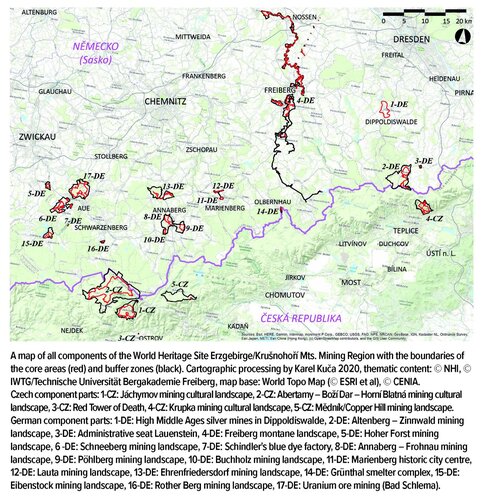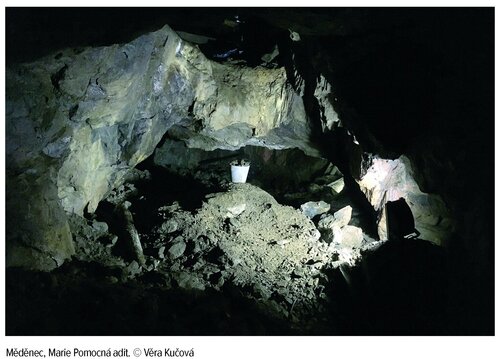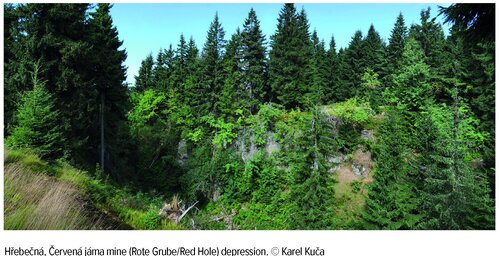The Journal is published by the Nature Conservation Agency of the Czech Republic in cooperation with the Cave Administration of the Czech Republic, the Krkonoše Mts. National Park Administration, the Bohemian Forest Mts. National Park Administration, the Podyjí National Park Administration and the The Bohemian Switzerland National Park Administration. It has been published since 1946.
cs / en
Nature Conservation 2021 — 10. 6. 2021 — On Nature in the Czech Republic — Print article in pdf
The Erzgebirge/Krušnohoří Mts. Mining Region as a World Heritage Site

In July 2019, the selected parts of the Bohemian and Saxon Erzgebirge/Krušnohoří Mts., also known as the Ore Mountains, were inscribed onto the UNESCO World Cultural and Natural Heritage List (World Heritage List). The area has long been associated in the public consciousness with the impacts of lignite/brown coal mining on the landscape and on forests at the foot of this extensive mountain range; we thus encountered a number of questions and doubts at the time of preparing the documents for nomination. Therefore, the article additionally contributes to clarifying how the cultural and historical values of the Erzgebirge/Krušnohoří Mts. stand out, and it is an inspiration for deepening interdisciplinary cooperation. Simultaneously, it is a contribution to the reflection on how to deal with these border mountains from the point of view of national protection in the future. Despite the high proportion of interesting landscapes, unlike other border massifs the Erzgebirge/Krušnohoří Mts. are, paradoxically, a mountain range which has been declared neither a national park nor a protected landscape area.
What is World Heritage in the Erzgebirge/Krušnohoří Mts.?
The main goal of the efforts to inscribe selected parts of the Erzgebirge/Krušnohoří on the World Heritage List was to preserve evidence of local polymetallic mining, which shaped the mountains for over eight centuries. As it turned out, it was unrealistic for the subject of nomination to be a larger continuous area. Thus, from a formal point of view, a series of 22 component parts, including several solitary monuments, become a World Heritage Site. There are seventeen component parts on the Saxon side, five on the Czech side; however, the size of the area in both countries is comparable.
In the Karlovy Vary region, these are the most valuable parts of landscape monument zones (hereinafter "LMZ"): the Abertamy–Horní Blatná–Boží Dar Mining Cultural Landscape1, where the historical part of the town of Horní Blatná was already protected, and the Jáchymov Mining Cultural Landscape2, with its base in the monument zone in the town of Jáchymov with, among others, the famous historical mint and the oldest uranium mine at the Svornost/Concorde Shaft. The Karlovy Vary part is complemented by Rudá věž smrti3 (‘Red Tower of Death’), a national cultural monument near the village of Dolní Žďár.
In the Ústí nad Labem Region, it is the Krupka Mining Cultural Landscape4, where the already protected town of Krupka has been complemented by a landscape with the Starý Martin adit and a large pinge on Komáří Hůrka/Mosquito Little Hill5. All this is connected by the old Hornická cesta/Mining Road6, which has already been protected as a cultural monument. The whole unit is complemented by the chapel of St. Wolfgang7 and a unique historic cable car8, allowing a view of the landscape below it. Simultaneously, the extensive former Knötel mining district9 was declared a cultural monument. In the western part of the region, the Háj–Kovářská–Mědník/Copper Hill Mining Cultural Landscape LMZ10 was prepared, where Mědník/ Copper Hill with the Rudný důl – Panna Marie Pomocná/Virgin Mary Help of Christians Adit and Země zaslíbená/Promised Land Adit Cultural Monument became part of the World Heritage Site.
It was a matter of course to include all three above-mentioned and (since 1992) protected mining towns. Uranium mining is also important in the history of the Erzgebirge/Krušnohoří Mts., misused to liquidate politically unsuitable people in labour camps around the town of Jáchymov. This is represented by parts of the Jáchymov region landscape and the nearby area of the Red Tower of Death National Cultural Monument, where negotiations on the handover to a departmental institution have been still ongoing.
In the Karlovy Vary region, the World Heritage Site is concentrated in the area covered by the municipality with extended powers (MEP) at Ostrov, relatively close to the city of Karlovy Vary/Carlsbad. At present, it is an area with a landscape which is especially attractive in the winter; well-explained values and tourism subsidiary infrastructure could increase interest there into year-round tourism. The Regional Office is the executive body of monument care/heritage conservation for the Red Tower of Death.
In the Ústí nad Labem region, the landscape north of the town of Krupka, with the executive body of monument care/heritage conservation within the MEP in the city of Teplice, is the traditional recreational area of the city of Ústí nad Labem, which is evidenced by the historic cable car just in the core area. The Mědník/Copper Hill component part is practically on the border with the Karlovy Vary region and falls within the responsibility of the Kadaň MEP.
How did it start and how was the selection made?
Saxony declared its intentions in the late 1990s. These efforts were temporarily delayed by the 2002 floods and Germany's frustration with the "deletion of Dresden" (2009) from the World Heritage List shortly after its inscription (2004). However, the locals did not give up and, on the Saxon side of the Erzgebirge/Krušnohoří Mts., monuments were repaired and provided with accompanying infrastructure. Simultaneously, cross-border communication between experts continued, with the Regional Museum in the city of Most in particular participating on behalf of the Czech partner.
Only in 2010 did the Ministry of Culture of the Czech Republic, thanks to intensive activity by the then Deputy Minister Anna Matoušková, include the nomination among the main tasks of the National Heritage Institute (NHI).
There was a difficult stage of decision-making in a short time period. It was not possible to get some municipalities and interesting places into the nomination for the concept of the region as a whole, to which Saxony was heading.
Some sites with already protected monuments had to be excluded so that the main concept would not become too "fragmented" into many subjects. Therefore, one of the few national cultural monuments in the region was not included in the wider selection – the large Cistercian monastery in Osek, whose grandiosity was related to silver and tin mining; however, it was not direct evidence of mining heritage. On the other hand, in the border villages of Cínovec, Hora Svatého Šebestiána, and Hora Svaté Kateřiny, the link to mining was closer; however, their construction authenticity and integrity suffered considerably in the second half of the 20th century.
Basic support was in the form of professional studies prepared for the Erzgebirge/Krušnohoří Mts. area by Michal Urban and his team, marking geologically significant places, including well-known ore districts, both in terms of area and sites.
The definition of suitable areas for protection in relation to already protected areas in the mining towns, solitary buildings, and important mining works was the basis for the preparation of LMZ. In the NHI, the topic of the cultural landscape was generally given more attention at the time: between 2011 and 2012, proposals were prepared for a total of five LMZ of various sizes. One of the goals was to obtain protection for the mining town of Mikulov, including the extremely interesting structure of Lehnschafter mine, but the municipality's management rejected the LMZ plan. Similarly, the original goal was to obtain protection for the surroundings of the flooded royal town of Přísečnice and the village of Kryštofovy Hamry. However, the plan had to be abandoned because the village preferred construction of a wind farm.
It was difficult to obtain area protection for the wider surroundings of Mědník/Copper Hill near the former mining town of Měděnec; in the end, the hill and the monument zone were declared a cultural monument, at least to a reduced extent.
Finally, the pragmatic approach of the Czech side to the selection of sites for nomination proved to be, paradoxically, more advantageous than that on the Saxon side; there, a lot of municipalities spent many years preparing for the nomination with the aim of including a much wider range of monuments, including areas that are not primarily related to the topic of mining but document, for example, the activities of a mining company in times outside the main mining season. Following reservations formulated by evaluators from the ranks of ICOMOS experts during 2015–2016, the number and extent of selected areas had to be changed, especially on the Saxon side, and in the second draft of the nomination some monuments were excluded. On the Czech side, the reduction concerned only one of the selected cultural monuments, namely the limestone quarry and the adjacent former quarry in Háj u Loučné pod Klínovcem cadastre.
Where to find more detailed information?
The World Heritage List is not just a list – it allows information to be obtained on outstanding cultural and natural values across continents in the World Heritage Centre’s information system in a user-friendly way (http://whc.unesco.org/).
Therefore, the aim there is not to repeat data that have already been available for the newly registered "Erzgebirge/Krušnohoří Mining Region" (http://whc.unesco.org/en/list/1478). A presentation by the non-profit company Montanregion, which is behind the entire project on the Czech side, also discusses the nature of the area and its values in more detail in three language versions. The portal http://www.montanregion.cz/cs/ also contains a number of illustrative photographs and has long reported on the entire course of the nomination, now a World Heritage Site. A joint presentation on the Erzgebirge/Krušnohoří Mts. is also provided by another multilingual portal called "Krušnohorsky/Erzgebirgisch" https://www.montanregion-erzgebirge.de/cz.html.
The Czech Republic must also provide information on its world monuments and update it in relevant publicly available data systems. Unlike national regulations which, after their adoption, usually enter into force several months apart, in the case of World Heritage, their status enters into force on the date of inscription. It is therefore advantageous if the nominated property and plots/territories have already been legally secured at the time of inscription and the state/public administration of them is stabilized both in terms of procedures and personnel. In the summer of 2019, therefore, basic information was prepared for the part of the website where the NHI reports on World Heritage (https://www.npu.cz/pamatky-unesco) and from where there are links to the entire Integrated Information System of Monument Care, including an application named Památkový katalog/Catalogue of Monument Care (https://pamatkovykatalog.cz/).
The Erzgebirge/Krušnohoří Mts. as an opportunity for interdisciplinary cooperation
For nature conservation, it is important that when presenting the legal framework for the protection of valuable areas and mining evidence it was necessary to use areas protected pursuant to Act No. 114/1992 Gazette on Nature Conservation and Landscape Protection, as amended later. The aim was to obtain sufficiently large protection zones for culturally valuable areas (‘buffer zone’ in World Heritage terminology11). For the purposes of nomination, protective regimes under other national legislation can be used to advantage if they are a guarantee that they will fulfil their conservation role.
These are Sites of European Importance (pursuant to Act No. 114/1992 Gazette on Nature Conservation and Landscape Protection, as amended later, the term for Site of Community Importance, SCI under the European Union’s Habitats Directive), Bird Areas (pursuant to the above act, the term for Special Protection Areas, SPA under the European Union´s Bird Directive), some small-size Specially Protected Areas, as well as Nature Parks. A significant overlap with the areas protected pursuant to the Act on Nature Conservation and Landscape Protection is the Božídarské rašeliniště Peatbog, in which the Blatenský příkop/Blatná Ditch (National) Cultural Monument12 is located, harbouring a unique artificial line working in the ridge of the mountains, established to improve the water regime at sites where panning took place, as evidenced by the name of the almost extinct village of Ryžovna/Seifen. The number of spoil heaps there is also interesting; thanks to their composition, they are distinguishable all year round by specific vegetation.
Of great interest in the Ústí nad Labem part of the Erzgebirge/Krušnohoří Mts. are, for example, large massifs of protective forests above the town of Krupka, in which there is an extraordinary density of medieval and early modern mining evidence.
Identification of preserved montane terrain with remains of mining activities has been made possible in recent years by the highly developed use of LIDAR images, which NHI specialists used to create a series of detailed thematic maps documenting the preserved terrain. In areas outside forests, the terrain was mostly aligned. However, the wooded parts of the newly declared World Heritage Site will challenge the close cooperation of all affected sectors and branches in landscape management, including forest management, so as not to lose the valuable evidence of the area's history.
Staffing is also important. Many people in the NHI were involved in the Erzgebirge/Krušnohoří Mts. We should mention Ondřej Malina from the NHI office at town of Loket and his professional approach; together with the Saxon partners, he helped to persuade foreign evaluators about the expert selection of areas with the potential of exceptional global value. The range of newly protected areas is large, yet there was no in-
crease in staffing of territorially relevant workplaces (in Ústí nad Labem and at Loket); however, the agenda of project assessment and spatial planning documentation increased in leaps and bounds. For future monitoring and tracking of changes (or rather "stability") of protected values, targeted checking mapping will be one of the tasks where it is necessary to combine human as well as financial capacities.
On the Czech side, the interest of the Erzgebirge/Krušnohoří Mts. landscape results from its small built-up area, or complete emptiness in some places, where only in recent years the history of the area has been remembered again. Mostly it is the individual and family nature of tourism, a certain remoteness from traditional centres and, last but not least, harshness of the local climate that are unique values, leading visitors to think about and imagine the processes that took place there during peak mining settlement. It would be a failure if the anticipated increased interest in new construction could not be managed so that the values set for World Heritage status for increased protection are not jeopardized by disproportionate investment, even if designed to increase attractiveness, visitor comfort, or bring more permanent inhabitants back to the area.
The future lies in cooperation
Cooperation between the State Nature Conservancy and National Heritage authorities will be needed in the development of management measures, both in Specially Protected Areas and in those parts of the Erzgebirge/Krušnohoří Mts. where there were not enough arguments or willingness to be included in the World Heritage, but which also possesses significant value for the historical cultural landscape. Increased visitor interest can accelerate the need for further interpretive activities by both disciplines so that they not only complement each other, but also prevent unnecessary damage, given the relatively new protection of these areas. In this context, it is impossible not to mention the impacts of wind energy development (which influenced, for example, the selection or delimitation in the vicinity of Mědník/Copper Hill) or lithium mining plans (around Cínovec and Krupka), for which it is necessary to discuss public interests carefully and timely.
The geological wealth of the Czech Republic and the associated heritage of mining activities is a little appreciated phenomenon, providing which is a challenge for cooperation between not only the NHI and the NCA CR, but also with the Czech Geological Survey (beyond geoparks, where occasional contacts through the Council of National Geoparks has already taken place).
Furthermore, with a high forest coverage, a number of watercourses and relict historical water works, the Erzgebirge/Krušnohoří Mts. provide many pilot areas for the search for optimal interdisciplinary and inter-sectoral cooperation for the protection, conservation and restoration of the specific cultural landscape.
It can therefore be assumed that inscription of parts of the Erzgebirge/Krušnohoří Mtzs. on the UNESCO World Heritage List has begun its social rehabilitation and will become the basis for interdisciplinary cooperation for at least the coming decades.
Notes
1 https://www.pamatkovykatalog.cz/hornicka-kulturni-krajina-abertamy-horni-blatna-bozi-dar-7664010
2 https://www.pamatkovykatalog.cz/hornicka-kulturni-krajina-jachymov-7664014
3 https://pamatkovykatalog.cz/pravni-ochrana/ruda-vez-smrti-v-ostrove-11347968
4 https://pamatkovykatalog.cz/pravni-ochrana/hornicka-kulturni-krajina-krupka-883868631
5 https://www.pamatkovykatalog.cz/velka-pinka-na-komari-vizce-13734422
6 https://www.pamatkovykatalog.cz/historicka-cesta-z-krupky-do-horni-krupky-13779449
7 https://www.pamatkovykatalog.cz/kaple-sv-wolfganga-13734513
8 https://www.pamatkovykatalog.cz/lanova-draha-bohosudov-komari-vizka-1264543
10 https://pamatkovykatalog.cz/hornicka-kulturni-krajina-haj-kovarska-mednik-7664018
11 Nárazníková zóna („buffer zone“) by v naší terminologii odpovídala funkci ochranného pásma, nemusí ale nutně kopírovat hranice ochranného pásma podle národních předpisů, a proto užíváme tento pojem.
12 https://pamatkovykatalog.cz/blatensky-vodni-prikop-12581736









